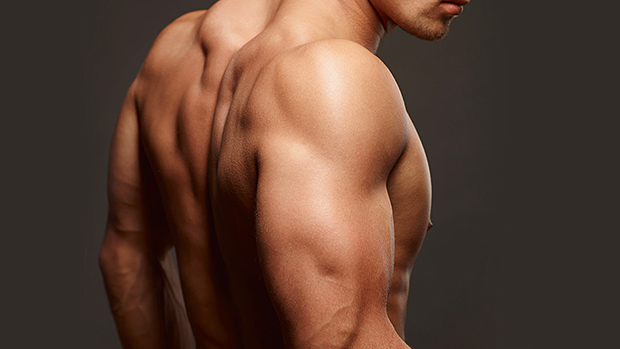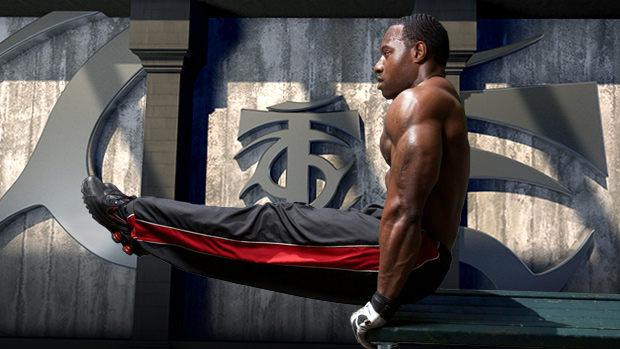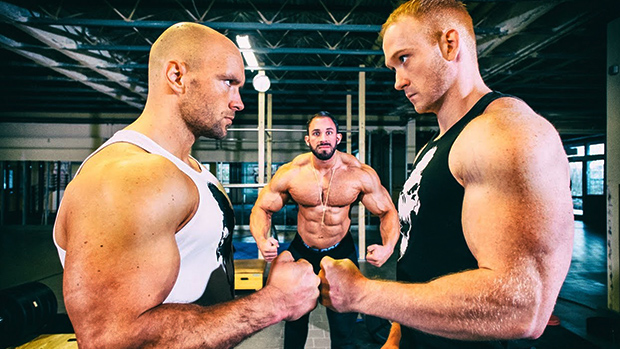Straighten Up!
Posture is the biggest equalizer when it comes to orthopedic health and function. The trends we're seeing in shoulder and spine injury and other dysfunction can be largely attributed to the sedentary nature of our society.
But even if you're not sedentary, you need to take a closer look at your posture. I've evaluated the posture of world-class athletes and will go on the record saying that high-performing physical outliers have just as dysfunctional – if not more dysfunctional – posture and positional awareness as the average desk jockey.
And people hate to hear (and see) that their posture sucks. But you know what they hate even more? Hearing that bodybuilding-style training is the best cure for cranky shoulders, achy necks, and posture that halts gains and leaves you hurting on a daily basis.
Sitting exacerbates pre-existing dysfunctions that often lay dormant in even the most active of populations. Fit or not, the cell phone, tablet, laptop, etc. have all taken a toll on our posture.
Weakness, stiffness, and general immobile muscles in the posterior shoulder girdle secondary to sitting can be a recipe for disaster when athletes do not account for these postural disturbances in their daily maintenance and more importantly their training programming.
Think of the many muscles of the upper back as postural stabilizers for the most part. The larger muscles of this group, most notably the posterior deltoid, teres major, mid and lower trapezius, and rhomboid complex are often neglected in the average lifter's program. And those who do make it a point to train the upper back often do so incorrectly.

Many programs revolve around mirror muscles like the pecs and biceps, but using bro-science logic, many turn to targeting the latissimus dorsi directly to rein in that push-to-pull focus into more generally acceptable ratios.
While the lats are located on the posterior aspect of the torso and connect into the humerus proximally, one big detail is often overlooked. The humeral insertion point of the lats is located on the medial aspect of the upper third of this upper arm bone, thus making it a shoulder internal rotator when actively contracted.
So when training the vertical (lat pulldown machine, chin-ups, pull-ups, or any other variation) you're digging the postural hole deeper and deeper, and actually adding to dysfunction and poor positioning.
Sure, having a spread that resembles a stingray is awesome, but cranking your shoulders and reinforcing the malposition won't give you the long term physical or functional benefits you're seeking.
If your shoulders are losing more mobility than the strength you're gaining, place a stronger emphasis on the row and its many variations. Keying in on the horizontal pull while maintaining a neutral or slightly externally rotated shoulder position will allow you to rearrange your posture while also going heavy.

Targeting the rear delts, rhomboids, mid to lower traps, and teres minor are the best ways to improve your posture. Adding size to each muscle in this region also makes you look like a boss.
By training the area directly, even the deeper, more acute contractile tissues of the region will be positively affected from a strength, stability, and functional standpoint.
The external rotator cuff comprised of the infraspinatus and teres minor can create more effective joint positions and centration of the shoulder complex, leading to smoother, more coordinated movement and contractions.
The smoother the movement of a joint, the better the gross action will be. This is why it's important to achieve and maintain proper shoulder spiraling and torque setups before going dynamic with your movements.
Traditional strength set and rep schemes won't cut it for upper back-emphasized training. Matching a muscle's primary action and function with the type of training it will respond more favorably to is the next step in achieving a posture that resembles more of a Greek god than Quasimodo.
When designing a program for any region of the body, match your volume and scheme according to the actions and functions of the muscles themselves.
The upper back responds well to increased volume, high reps and time under tension. This should be no shock, as many of these muscles function to keep your shoulders in the sockets, and keeping your thoracic spine and neck somewhat erect when you're interacting with your social environment.
Targeting these muscles with power or strength schemes is inappropriate for a majority of athletes and lifters. Putting a larger emphasis on metabolic stress and the pump will produce greater aesthetic results, in addition to more functional and transferable strength results.
Tapping into the mind-muscle connection and using proper workloads and volumes can do amazing things for enhancing posture and unlocking the emergency brake you may have had on your lifting performance for years.
Here are two of the best upper-back specific movements and how to program them throughout a number of variations for a thicker backside, stronger pulls and presses, and overall less pitiful posture.
Dynamic Warm-Up
- Sets: 3-5
- Reps: 8-12
- Rest: 10-25 seconds
- Tempo: 10X1
- Take 1 second to lower the weight.
- Spend 0 seconds at the bottom of the movement.
- Explode up to the top of the movement.
- Pause for one second at the top (peak contraction) of the movement before lowering again.
Notes
Using the accommodating resistance out of the band, explode back, maintaining the elbows slightly higher than the shoulders. At peak contraction, your shoulders should be slightly externally rotated with loads of torque and tension through the upper back. Hold that position for a second and control your arms back straight and jump right into the next rep.
Strength Movement
- Sets: 5-9
- Reps: 12-20
- Rest: 30-45 seconds
- Tempo: 21X1
Notes
Time to load up with the rope and cable rack setup. Drive your elbows back, squeezing your shoulder blades together and hold for a second at peak contraction. As you load heavier, the slight external rotation of the shoulders on the backside along with the relative position of your elbows above the shoulders will both decrease. This is fine, just be sure to control the eccentric portion of the movement and pause with elbows extended to minimize the use of momentum.
Metabolic Shoulder Finisher
- Sets: 2-4
- Reps: 30-50
- Rest: 30-45 seconds
- Tempo: Constant tension – no holds just smooth coordinated eccentric/concentric movements.
Notes
Using constant tension with no holds on the front or backside of the movement, crank out 50 controlled reps and fight the urge to quit. As the pain ensues, don't let your form suffer. Keep those elbows above shoulders at all times.
Dynamic Warm-Up
- Sets: 3-5
- Reps: 10-15
- Rest: 10-25 seconds
- Tempo: 10X1
Notes
Get a light band under your feet and grab onto the ends with your hands in a palms-down position. Slump over with your chest approximating your knees while keeping your neck in a neutral position. Drive your arms up and hold for a second at the top of the range before controlling your hands back down towards the ground. You'll really feel these top isometric holds with the accommodating band resistance that will drive blood into the upper back quickly and efficiently.
Strength Movement
- Sets: 5-7
- Reps: 15-20
- Rest: 20-30 seconds
- Tempo: 20X1
Notes
Get a pair of dumbbells in your hands and don't let your ego drive your working weights. From the same position as the dynamic warm-up variation, drive up the dumbbells with your palms down, hold for a second and accentuate the eccentric portion of the movement with a two second descent. A set of 20 will be excruciating towards the end, that's why it's imperative to choose working weights that you can maintain your range of motion into the top position for all prescribed reps.
Metabolic Shoulder Finisher
- Sets: 2-4
- Reps: 30-50 with partial reps
- Rest: 30-45 seconds
- Tempo: Constant tension – no holds just smooth coordinated eccentric/concentric movements.
Notes
If you thought you had to go light in the strength variation of this movement, you'll be humbled even more when programming for metabolic stress and finishing off a training day. Use constant tension, working smoothly up and down with great scapular retraction on every rep. Even at the lightest weights, 50 reps will catch up with you quickly. Instead of cheating the movement and losing tension, continue to knock back reps with constant tension with partial range reps. Focus on keeping the weights moving until you get to 50, then enjoy that 30 second rest period because you'll have a few more rounds to go.
You're not limited to these exercises. They simply show how you can manipulate any movement that targets the upper back with three different training mechanisms: iso-holds, constant tension, and straight loaded strength sets.
Bodybuilding-style execution and the mind-muscle connection are keys to reaching your postural and performance goals. As a movement becomes more compound, the need for clean and crisp movement with intention becomes that much more important.
Start slow with more isolated movements and work your way up to big rowing variations and other more metabolically demanding movements.
The options are endless, but don't be the guy super-setting bench with lat pulldown three times per week and bitching when your shoulders hurt and your upper back is about to explode. You've been warned.





